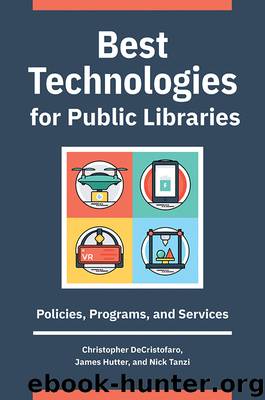Best Technologies for Public Libraries by Christopher DeCristofaro

Author:Christopher DeCristofaro
Language: eng
Format: epub
Publisher: ABC-CLIO
Published: 2020-03-14T16:00:00+00:00
MERGE Cube and the Dig! App
Often, AR applications may require unique pieces of hardware to accompany them. This is exactly the case with the MERGE cube. At first, the cube can be a bit puzzling in appearance. It is clear that it is cleverly designed to serve some sort of function. Once the software component is launched and utilized with the MERGE cube, some extremely astonishing AR magic becomes quickly apparent.
What is unique about the MERGE Cube is how mysteriously conspicuous it appears. It is a black cube covered in strange markings and, to the casual observer, it would be hard to tell that it has any sort of technology implications (“AR/VR Learning & Creation,” n.d.). In reality, the markings on the cube almost serve as QR codes (otherwise known as Quick Response Codes), which are unique identifiers that camera-based software on smartphones and tablets can recognize. These QR codes are highly specific, can be easily user generated, and typically take smartphone users to informational websites. In the case of the MERGE Cube, all six sides of the cube are covered in these unique markings. Any apps written to use the MERGE Cube platform can recognize these proprietary codes and tell what side of the cube is facing the smartphone camera. As a person holds this cube in the air and moves it in their hands, the MERGE Cube software recognizes the cube codes and knows to manipulate a rendered object on the screen accordingly.
A fun way to demonstrate the MERGE Cube for staff can be through the use of their free “Dig!” app (“Dig! for Merge Cube,” n.d.). It is hard to deny that this game carries a passing resemblance to the insanely popular game Minecraft. The Dig! App uses a very similar art style. In this particular game, the MERGE Cube acts as a tiny world—almost like a miniature planet—that rests in your hands. As the user, you are able to modify the terrain of the planet using small pixelated blocks. These blocks represent a variety of art styles and characteristics. Some of the blocks look like stone, some look like grass, some like tree bark, and others like tree leaves (see figure 3.2). Overall, the aesthetic is very “Minecraft-like,” with users creating castles and homes on their tiny worlds, built out of even smaller cubes.
What should hopefully resonate with staff when they play with this app is how they can move the cube around in front of a tablet or smartphone screen and see their creation from every possible angle. Some portions of the world are even animated—objects like water will flow across the surface. This game should be easy for anyone to pick up and play with and should generate some instant smiles from staff experimenting with it.
Download
This site does not store any files on its server. We only index and link to content provided by other sites. Please contact the content providers to delete copyright contents if any and email us, we'll remove relevant links or contents immediately.
Cecilia; Or, Memoirs of an Heiress — Volume 1 by Fanny Burney(32433)
Cecilia; Or, Memoirs of an Heiress — Volume 2 by Fanny Burney(31866)
Cecilia; Or, Memoirs of an Heiress — Volume 3 by Fanny Burney(31850)
The Great Music City by Andrea Baker(31319)
We're Going to Need More Wine by Gabrielle Union(18967)
All the Missing Girls by Megan Miranda(15559)
Pimp by Iceberg Slim(14375)
Bombshells: Glamour Girls of a Lifetime by Sullivan Steve(13970)
Talking to Strangers by Malcolm Gladwell(13218)
Norse Mythology by Gaiman Neil(13202)
Fifty Shades Freed by E L James(13157)
For the Love of Europe by Rick Steves(12910)
Mindhunter: Inside the FBI's Elite Serial Crime Unit by John E. Douglas & Mark Olshaker(9186)
Crazy Rich Asians by Kevin Kwan(9164)
The Lost Art of Listening by Michael P. Nichols(7403)
Enlightenment Now: The Case for Reason, Science, Humanism, and Progress by Steven Pinker(7226)
The Four Agreements by Don Miguel Ruiz(6618)
Bad Blood by John Carreyrou(6543)
Weapons of Math Destruction by Cathy O'Neil(6139)
